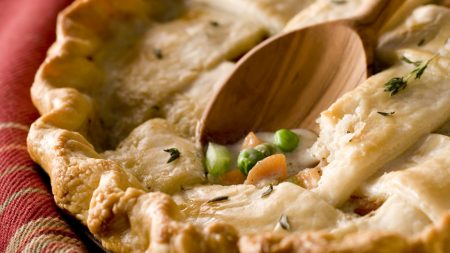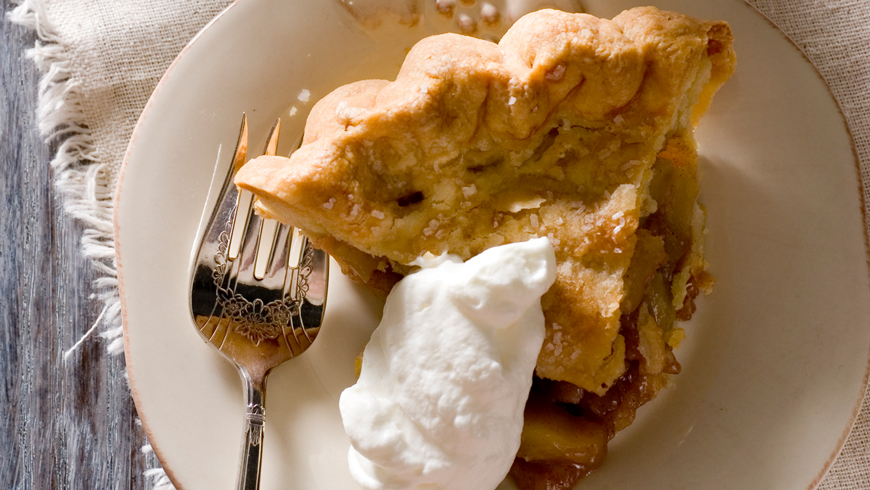Utter the word “pie” and something wonderfully strange happens. Warm and fuzzy feel-good memories flood the brain. Desserts of all stripes set off dopamine receptors—those neurotransmitters that deliver pleasure signals to the cerebrum—but pie holds a special place in the heart as well as the head. Pie embodies family, tradition, home. Cake? Birthdays.
Imperfect, with flaky crumbs and cracks and bubbled-out fillings, pie can never pull off the finesse of a coifed cake. Pie is humble; cake is fancy. People turn to pie for comfort and to cake to celebrate.
Pie isn’t relegated to any particular season—it’s eaten year-round—although two seem particularly suited. Abundant summer and fall fruits grant pie-making special privileges: embarrassing riches of berries, juicy stone fruits, tart apples and sugary pears seem preordained for pie. But pie isn’t consigned to the sweet category alone. Savory pies hold their own in American cuisine: pot pies, vegetable pies, meat pies and more.
A Short History
“As American as apple pie” is a colloquialism without specific attribution, but a familiar phrase in the United States. Americans didn’t invent apple pie—the first known recipe is an English one dated from 1381—but we have embraced it with gusto. According to a Harris Poll conducted in March 2017, Americans named apple their favorite pie, with pizza coming in second (a whole other discussion), followed by chocolate, pecan and cherry.
Pie predates the Middle Ages. Historians believe the ancient Egyptians created pie by baking bread dough stuffed with fillings—predominately meat—in kilns. The dough was merely a vehicle, referred to as a “coffyn,” to hold the filling, and the crust, which wasn’t eaten, was potentially used more than once. Ancient Romans covered their fillings to preserve the moisture during baking but also discarded the crust before eating. Those “pies” were not what pie is today, which is to say a tender pastry crust holding or encasing a filling. When fat—butter, shortening, lard—is added to dough (flour and water), it becomes pastry.
It’s All About the Crust
Pie seems to be more of a home-baked treat in the Wood River Valley. Few restaurants serve pie regularly, with the exception of the Sun Valley Golf Club, which serves only a savory option, but a stellar one, turkey pot pie, and Rasberrys Bistro and Catering in Ketchum, which serves a plethora of sweet and savory pies. Other restaurants occasionally run pies—sweet or savory—as specials.
 What makes a great pie? “The crust,” Maeme Rasberry said. “It’s all about the crust.”
What makes a great pie? “The crust,” Maeme Rasberry said. “It’s all about the crust.”
Mother-and-son Julie and Riley Heneghan make and bake most pies at Rasberrys these days, but Maeme used to do all the baking. Co-owner and Maeme’s twin, Callie, confessed she doesn’t bake. At all. “I have the creative part down,” Callie said. “I can say ‘Hey, what about this combo or that combo,’ but even to roll out pie dough? I’m probably a complete failure.”
The Rasberrys’ chefs learned an appreciation for pie from their paternal grandmother. “Lucille—we didn’t call her grandma—would lay out all these pies at Thanksgiving,” Callie said. “Pecan pie, pumpkin, and apple brown butter. So many pies. I don’t bake it, but I sure love to eat it.”
Rasberrys makes only one kind of pie dough for all its pies, whether it’s apple, cherry, raspberry, peach, pear or plum; ditto for the savory pies: chicken, turkey or vegetable. “We do an all-butter crust. I don’t use shortening because I don’t like hydrogenated oils.”
Home cooks shouldn’t fret the dough. “It’s easier than it seems,” Maeme said. If fitting dough into a pie tin is intimidating, make a free-form pie: roll the dough into a circle—it doesn’t even have to be perfect—and place the filling in the center. Fold over the dough by hand into rustic pleats.
Inspiration for Fall Pies
“Farmers load us up with extra crops during their season. We’ll take whatever they have and then freeze it to use later,” Maeme said. “If it’s raspberries or cherries, we’ll put them on sheet trays to freeze in a single layer, and then transfer them into Ziploc bags. That way they’re not frozen into a big clump of fruit.”
Rasberrys’ bakers love to mix summer and fall fruits together: think raspberry and rhubarb, blueberry and plum, pear and sour cherry. On the savory side, Maeme loves tomato pies with cheddar cheese and bacon, perhaps with a binder of mayonnaise, or tomato and basil topped with pesto and Parmesan.
“Chicken pot pies are the first thing to go at the farmers’ market,” she said. Rasberrys brings an assortment of individual-portion pies—sweet and savory—to the Ketchum Farmers’ Market (held at Ketchum Town Square Tuesday afternoons from 2 p.m. to 6 p.m. through October 9).
On the savory side, Rasberrys sometimes offers pies made with spinach, kale, arugula, garlic, lemon zest, basil and feta. “It’s like spanakopita, but with pie dough instead of filo dough,” Maeme said. Vegetables—especially squash, carrots, and such—make great vegetarian pies. “Mushrooms, too,” she said. “At home, try mushrooms and spinach together.”
Leftovers make great pies. “Take your leftovers and put them into a pie. Leftover turkey in a pot pie topped with stuffing is terrific,” Maeme said. “That’s what pies were for originally: leftovers. Like shepherd’s pie topped with leftover mashed potatoes.”
There is no shortage of inspiration for making pies—fresh farm produce or last night’s leftovers. Master the crust (see Maeme’s tips) and get in the kitchen to bake a pie. Save the cake for a birthday.
MAEME RASBERRY’S TIPS FOR PERFECT PIE DOUGH
- Use quality ingredients: unbleached flour, sea salt and high-fat butter (European-style butter such as Straus Family Creamery (85%) or Plugrá (82%) for example).
- Use a scale. Everyone measures flour differently, so a simple kitchen scale takes out the guesswork. Pie recipes worth their “weight” are in metric.
- Start with cold ingredients. Cold butter is crucial. Cut the butter into small cubes and freeze before using.
- Use a food processor to make quick work of mixing. Overworking dough with warm hands can result in tough dough.
- Pulse the flour and butter a few times to create pea-size crumbs, then with the motor running, drizzle in cold ice water. Stop the machine just as the dough starts to come together.
- After mixing, let dough rest for 30 minutes in the fridge (wrapped) to relax the gluten.
- Before baking, brush crust with an egg wash for a gleaming, golden-brown crust.
- Cook pies in a 400 ˚F oven to set and seal the crust.
- Keep pie dough in the freezer, and you’ll always have pie at the ready.


